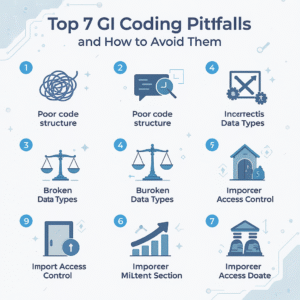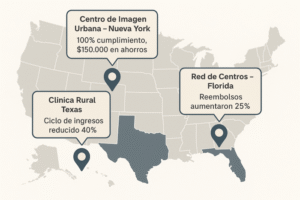How Inaccurate Coding Leads to Revenue Leakage: The Hidden Threat to Your Bottom Line
Inaccurate Coding Leads
Inaccurate Coding Leads
In today’s complex healthcare landscape, accurate medical coding serves as the backbone of revenue cycle management. Yet, despite its critical importance, coding inaccuracies continue to plague healthcare organizations worldwide, creating a silent but devastating drain on financial resources. Revenue leakage due to inaccurate coding represents one of the most significant yet preventable threats to healthcare profitability, with industry studies suggesting that organizations lose between 1-5% of their total revenue annually due to coding errors alone.

Understanding the intricate relationship between coding accuracy and revenue integrity is essential for healthcare leaders, revenue cycle managers, and coding professionals who are committed to optimizing their organization’s financial performance. This comprehensive exploration will delve into the mechanisms by which inaccurate coding creates revenue leakage, examine the root causes of these costly errors, and provide actionable strategies for prevention and mitigation.
The Foundation of Revenue Cycle Management
Medical coding forms the cornerstone of healthcare revenue generation, serving as the critical translation layer between clinical services and financial reimbursement. Every patient encounter, procedure, diagnosis, and service must be accurately captured and coded using standardized classification systems such as ICD-10-CM, CPT, and HCPCS. These codes serve multiple purposes: they communicate clinical information to payers, justify medical necessity, determine reimbursement rates, and ensure compliance with regulatory requirements.
The complexity of modern medical coding cannot be overstated. With over 70,000 ICD-10-CM diagnosis codes and thousands of CPT procedure codes, each with specific guidelines, modifiers, and bundling rules, the potential for error is substantial. Furthermore, coding requirements are constantly evolving, with annual updates, new guidelines, and changing payer policies adding layers of complexity that even experienced coders must navigate carefully.
When coding is performed accurately, it creates a seamless flow from service delivery to payment collection. However, when errors occur, they disrupt this flow and create multiple points where revenue can leak from the system. These leaks can manifest as claim denials, reduced reimbursement, compliance penalties, and administrative costs associated with rework and appeals.
The Mechanisms of Revenue Leakage Through Coding Errors
Revenue leakage through inaccurate coding occurs through several distinct but interconnected mechanisms, each capable of significantly impacting an organization’s financial performance. Understanding these mechanisms is crucial for developing effective prevention strategies and identifying areas of vulnerability within the revenue cycle.
Undercoding and Lost Revenue Opportunities
Undercoding represents one of the most insidious forms of revenue leakage because it often goes undetected by traditional audit processes. When services are coded at a lower level of complexity than actually provided, or when additional billable services are omitted entirely, organizations fail to capture the full value of the care delivered. This conservative coding approach, while potentially reducing audit risk, systematically undervalues clinical services and creates substantial revenue losses over time.
Consider a scenario where a complex evaluation and management visit is consistently coded as a standard visit due to inadequate documentation review or coder uncertainty. The difference in reimbursement between these code levels can be significant, and when multiplied across thousands of encounters annually, the cumulative revenue loss can reach hundreds of thousands of dollars. Similarly, failure to capture ancillary services, appropriate modifiers, or additional diagnosis codes that support higher reimbursement rates creates ongoing revenue leakage that compounds over time.

Overcoding and Compliance Consequences
While undercoding represents lost revenue opportunities, overcoding creates a different but equally damaging form of revenue impact. When services are coded at higher levels than supported by documentation or clinical reality, organizations face significant compliance risks that can result in penalties, recoupments, and reputational damage far exceeding any short-term revenue gains.
Overcoding violations can trigger audits by government agencies, commercial payers, and internal compliance programs. These audits often result in demands for refunds of overpayments, extrapolated penalties based on sample findings, and ongoing monitoring requirements that consume significant administrative resources. The financial impact of overcoding extends beyond immediate penalties to include legal fees, consultant costs, and the opportunity cost of diverted staff resources.
Claim Denials and Administrative Burden
Inaccurate coding is a leading cause of claim denials, creating immediate revenue interruption and imposing substantial administrative costs on organizations. When claims are denied due to coding errors, revenue is delayed while staff resources are diverted to research, correct, and resubmit claims. This process not only delays payment but also increases the cost of collection and reduces overall operational efficiency.
The administrative burden associated with denied claims extends beyond the immediate rework requirements. Each denied claim must be researched to identify the root cause, corrected according to payer requirements, and resubmitted through the appropriate channels. This process often requires coordination between coding, billing, and clinical staff, consuming valuable resources that could otherwise be dedicated to productive revenue-generating activities.
Furthermore, some denied claims are never successfully resolved, resulting in complete revenue loss for services that were legitimately provided but incorrectly coded. These write-offs represent pure revenue leakage that directly impacts the organization’s bottom line and can accumulate to significant amounts over time.
Root Causes of Coding Inaccuracies
Understanding the underlying causes of coding inaccuracies is essential for developing effective prevention strategies. These causes are multifaceted and often interconnected, requiring comprehensive approaches that address systemic issues rather than isolated problems.
Inadequate Documentation
Poor clinical documentation serves as the foundation for most coding errors. When physicians and other providers fail to document services comprehensively, accurately, or in compliance with coding guidelines, coders are left to interpret incomplete information or make assumptions that may not reflect the true nature of services provided. This documentation gap creates uncertainty that inevitably leads to coding inaccuracies and revenue leakage.
Documentation deficiencies take many forms, from missing elements required for specific code assignments to ambiguous language that prevents accurate code selection. Time pressures, electronic health record limitations, and insufficient provider education about documentation requirements all contribute to this persistent problem. The impact extends beyond coding accuracy to affect compliance, quality reporting, and patient care coordination.
Insufficient Coder Training and Education
The complexity of medical coding requires ongoing education and training to maintain accuracy and stay current with evolving guidelines. However, many organizations underinvest in coder development, leading to knowledge gaps that manifest as coding errors and revenue leakage. New coders may lack sufficient depth of knowledge to handle complex cases, while experienced coders may fall behind on guideline updates or specialty-specific requirements.
The rapid pace of change in healthcare coding amplifies the importance of continuous education. Annual code updates, new guidelines, emerging technologies, and changing payer policies create a dynamic environment where yesterday’s knowledge may be insufficient for today’s coding challenges. Organizations that fail to provide adequate ongoing education create conditions where coding inaccuracies become inevitable.
Technology Limitations and System Issues
While technology has the potential to improve coding accuracy through automated tools, alerts, and decision support systems, inadequate or poorly implemented technology can actually contribute to coding errors. Outdated coding software, systems that lack current guidelines, or platforms that don’t integrate well with clinical documentation can create barriers to accurate coding and increase the likelihood of errors.
Electronic health record systems that don’t support efficient coding workflows or provide adequate clinical context can force coders to work with incomplete information or navigate cumbersome processes that increase error rates. Similarly, billing systems that don’t validate codes against current guidelines or payer requirements may allow inaccurate codes to be submitted, resulting in denials and revenue leakage.

Workflow and Process Deficiencies
Coding accuracy depends not only on individual coder competency but also on well-designed workflows and processes that support consistent, thorough code assignment. Organizations with inadequate quality assurance processes, insufficient review mechanisms, or poorly defined coding protocols create environments where errors can occur and persist undetected.
Time pressures and productivity demands can also contribute to coding inaccuracies when coders are required to process large volumes of records quickly without adequate time for thorough analysis. While efficiency is important, unrealistic productivity expectations that compromise accuracy ultimately harm revenue performance through increased errors and rework requirements.
The Financial Impact of Revenue Leakage
The financial implications of revenue leakage through inaccurate coding extend far beyond the immediate impact of individual coding errors. When examined at the organizational level, these seemingly small inaccuracies aggregate into substantial financial losses that can significantly impact profitability, cash flow, and long-term sustainability.
Industry research consistently demonstrates that healthcare organizations lose substantial revenue annually due to coding inaccuracies. Conservative estimates suggest that revenue leakage rates of 1-3% are common, with some organizations experiencing losses of 5% or more. For a typical hospital with annual revenue of $500 million, even a 2% leakage rate represents $10 million in lost revenue annually—funds that could otherwise support patient care, facility improvements, technology investments, or staff development.
The cumulative nature of revenue leakage makes it particularly insidious. Unlike one-time expenses or clearly identifiable losses, revenue leakage occurs gradually and consistently, making it difficult to detect and quantify without systematic analysis. This gradual erosion of revenue can mask underlying problems and delay corrective action, allowing losses to compound over time.
Beyond the immediate financial impact, revenue leakage affects organizational performance in multiple ways. Reduced cash flow can limit investment capacity, affect credit ratings, and constrain strategic initiatives. The administrative costs associated with managing coding errors, processing denials, and conducting rework activities represent additional drains on resources that could otherwise be used productively.
Prevention Strategies and Best Practices
Preventing revenue leakage through improved coding accuracy requires a comprehensive approach that addresses the root causes of coding errors while implementing systematic controls and monitoring mechanisms. Successful organizations typically employ multiple complementary strategies that work together to create a culture of accuracy and continuous improvement.
Comprehensive Documentation Improvement Programs
Addressing documentation deficiencies requires ongoing collaboration between coding and clinical staff to identify gaps, provide education, and implement systematic improvements. Effective programs typically include provider education about documentation requirements, real-time feedback on documentation quality, and technology solutions that prompt for complete information during the documentation process.
Regular documentation audits can identify patterns of deficiency and guide targeted improvement efforts. When physicians understand how documentation affects coding accuracy and revenue capture, they are more likely to invest the additional time and attention required for comprehensive documentation. This collaborative approach benefits both revenue performance and patient care quality.
Advanced Coder Training and Certification Programs
Investing in comprehensive coder education and ongoing professional development is essential for maintaining coding accuracy in an increasingly complex environment. Effective training programs should address not only technical coding skills but also anatomy, pathophysiology, medical terminology, and regulatory requirements that support accurate code assignment.
Certification requirements, specialty training, and continuing education mandates help ensure that coders maintain current knowledge and skills. Organizations that invest in advanced training often see improved coding accuracy, reduced denial rates, and enhanced coder job satisfaction and retention.
Technology Solutions and Automation
Modern coding technology offers significant opportunities to improve accuracy and reduce revenue leakage. Computer-assisted coding systems can suggest appropriate codes based on clinical documentation, while automated auditing tools can identify potential errors before claims are submitted. These technologies don’t replace human expertise but rather enhance coder capabilities and reduce the likelihood of errors.
Implementation of comprehensive technology solutions should include adequate training, ongoing support, and regular updates to ensure optimal performance. The most effective systems integrate seamlessly with existing workflows and provide decision support that enhances rather than complicates the coding process.
Quality Assurance and Monitoring Programs

Systematic quality assurance programs are essential for identifying coding errors, measuring accuracy rates, and driving continuous improvement. Effective programs typically include regular auditing of coded records, feedback to individual coders, trending analysis to identify patterns, and corrective action plans to address identified deficiencies.
Pre-bill auditing can identify and correct errors before claims are submitted, preventing denials and reducing rework requirements. Post-payment auditing helps identify systemic issues and provides data for process improvements. The combination of preventive and detective controls creates a comprehensive quality framework that supports sustained accuracy improvements.
Conclusion: Building a Revenue-Intact Future
The challenge of preventing revenue leakage through accurate coding requires sustained commitment, comprehensive strategies, and ongoing vigilance. Organizations that recognize coding accuracy as a strategic priority and invest accordingly typically achieve better financial performance, improved compliance outcomes, and enhanced operational efficiency.
Success in this endeavor requires leadership commitment, cross-functional collaboration, adequate resource allocation, and a culture that values accuracy and continuous improvement. While the initial investment in improved coding processes may be substantial, the long-term benefits of reduced revenue leakage, improved cash flow, and enhanced compliance far outweigh the costs.
As healthcare continues to evolve with new technologies, changing regulations, and increasing complexity, the importance of accurate coding will only grow. Organizations that proactively address coding accuracy today will be better positioned to thrive in tomorrow’s healthcare environment, while those that ignore this critical issue will continue to suffer from preventable revenue leakage that undermines their financial stability and mission achievement.
The path forward requires commitment, investment, and persistence, but the rewards—measured in improved revenue performance, reduced compliance risk, and enhanced organizational sustainability—make this journey not just worthwhile but essential for long-term success in healthcare.



